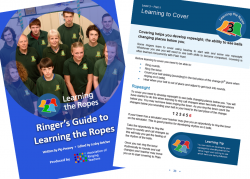A Ringer's Guide to Learning the Ropes
This new book written by Pip Penney and produced by ART is aimed at new and progressing ringers. It brings together in one place a comprehensive guide to support the ringer from bell handling to ringing Bob Minor inside.
It is a very colourful and attractively presented book, full of diagrams and pictures with simple descriptions which help explain the complexities of learning to ring to a learner of any age. Theory is explained in a straightforward way with excellent illustrations and regular quizzes to aid understanding.
Starting with the basics of bell handling, safety aspects are covered, along with the importance of developing a good and efficient handling style to achieve the all important bell control. What that actually means is shown using a series of photographs and simple descriptions. The techniques required to raise and lower a bell are covered at this stage with tips on how to learn – in the tower and at home!
Progressing to ringing rounds and foundation skills, advice with tips and practice ideas is given on how to learn listening skills, rhythm and striking, ropesight and leading, before moving on to Call Changes, kaleidoscope ringing and covering.
The skills and theory required to ring Plain Hunt are handled in some detail, with recommendations on how to approach learning hunting in a structured way and an introduction to some of the jargon ringers use. Continuing the theme of progressive learning the book moves on to Bob Doubles, Grandsire and Bob Minor skirting with treble bob hunt exercises and how to call a touch along the way.
At 80 pages it is an attractive, simple & straightforward guide to support learning at this level – now available at £6.80 including postage.
» Order your copy from the ART shop
Read the Review
If you are a teacher of ringing, A Ringer’s Guide to Learning the Ropes says all of the things that you want to tell your new ringers as they learn, but if you did they would never have time to do any ringing. It should be on the ‘recommended reading’ list for any new ringer. Its seventy-nine pages are packed with essential information and handy tips which will help light the way down the path to method ringing that for years many ringers have stumbled along, some getting lost and others emerging in the bright sunshine almost by chance.
For ringers registered on the Association of Ringing Teachers’ Learning the Ropes scheme this is the perfect companion to the Personal Progress Logbook that they receive as they take their first few steps. There are six sections that parallel the new ringer’s journey through the five Levels of Learning the Ropes – the final section is sensibly divided into two to cover ringing Minor methods and elementary conducting. Just like the scheme A Ringer’s Guide to Learning the Ropes takes small incremental steps to get you from the beginning of each section to the end, so you can dip in and out consolidating what you have just learned, revise just before your next session and take a sneak preview of what is just around the corner.
Good teachers plan lessons and set targets. Each section starts with a set of goals and finishes with a ‘progress report’ for the new ringer to self-check that they have understood and mastered the skills for that Level. This is a good stratagem. How many hours have you spent reassuring tearful students of ringing that their progress is fine and that trying to ring plain hunt before mastering the foundation skills is a fool’s errand? Helpful learning tips, as timely reminders of what to focus on, pop up at regular intervals throughout the book and there are quizzes to make sure that theoretical knowledge is up to scratch. The resources in the book have brought into print just some of the resources that can be found on the SmART Ringer website making them available to anyone, whether registered with the scheme or not and in the introduction there is information on how to connect with the Learning the Ropes Website.
Just like the best sort of teacher A Ringer’s Guide to Learning the Ropes recognises that people learn in different ways and frequently offers more than one method of putting theoretical knowledge into practice. There are clear explanations of how to acquire skills that many new ringers find difficult, such as ropesight. And, like the Learning the Ropes programme, simple conducting exercises are introduced early on in the journey from novice to method ringer.
The presentation of A Ringer’s Guide to Learning the Ropes is a bit of a mixed bag. On one hand the presentation is cheerful with plenty of colour photographs, illustrations and diagrams. The diagrams are clear and helpful. On the other hand some of the photographs and illustrations, especially in the earlier sections, lack definition. I expect that this must be a production constraint, but wonder how much better they would be on glossy paper.
As a comprehensive starter book taking the new ringer from their first bell handling lesson to calling touches of Doubles and Minor for Sunday service A Ringer’s Guide to Learning the Ropes
is excellent value for money at £6.80. It is written in a clear and uncomplicated style which should appeal to all age groups. I have no hesitation in recommending it.
Clare McArdle

Graham Nabb, ART Chairman